Leica X Vario: Damages to the Camera
Broken Battery Locking Slider | Tripod-Made Scratches | Dust in the Lens or on the Sensor? | Dust on the Sensor (2) | Shutter Button | Issues Reported by Other Users
Archive
On this page I would like to cover the more dark sides of owning a camera, and a Leica X Vario in particular: damages - I did not find a better word up to now - that happen to the camera by simply using it. Some of them may be the user's fault, but some are probably the result of "cheap design." Where applicable, I will also point to how you can repair or prevent the damage...
Here, I will focus on issues that I experienced, but at the bottom, I will also briefly touch issues that other users reported.
Broken Battery Locking Slider
Update (November 2016): I was notified by a German Leica X Vario user that the replacement battery locking slider that he had received from Leica az no cost looked somewhat differently at the back (no pin to put the spring on, but a hole for insertig the spring).
After a little more that half a year it happened: The plastic battery locking slider (German: Akku-Verriegelungsschieber) broke when I exchanged the battery. I had such an incident with my Ricoh cameras twice, but I had to let them drop to the ground to make that happen. Here I really did not exert any undue force. Anyway, even though such a mishap may be disturbing, the camera can still be used, because the lid of the battery compartment presses the battery in place and secures the electrical contact between the camera and the battery.
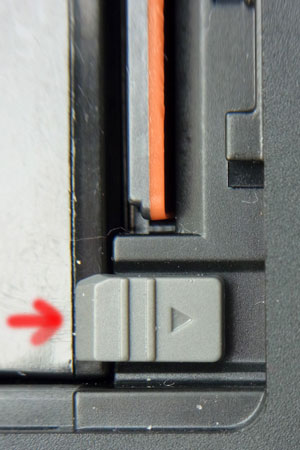 |
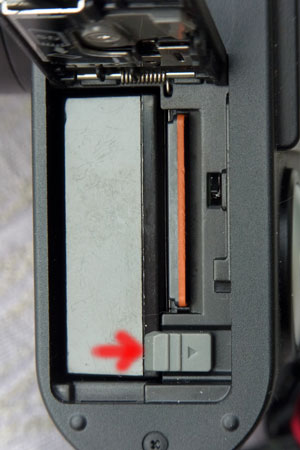 |
Photos: The plastic battery locking slider (German: Akku-Verriegelungsschieber), which broke; this is already the replacement part after my repair.
The same evening, I stumbled across a posting in the German X camera thread of the l-camera-forum and soon found out that exactly my problem was described there - and also how to resolve it. The poster had called the Leica service and they sent him a replacement part so that he could fix the issue himself. Of course, he could also have sent the camera to Leica for repair. Actually, the repair had its pitfalls, and I would like to refer you to the posting for the point - I will not disclose it here. But eventually, the repair was successful.
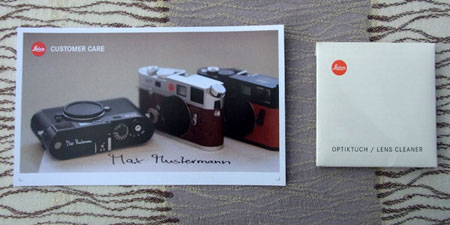 |
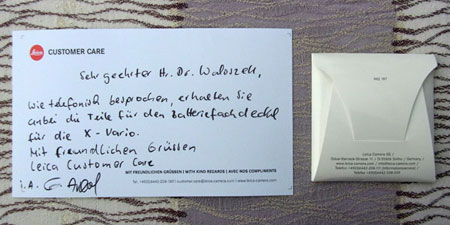 |
Photos: A notice from Leica plus a small present... (click images for larger versions)
So I called the Leica service myself and, after some to and fro, they agreed to send me a replacement part. A couple of days later, it arrived (see the notice and a small present above), and I eagerly turned to the task of fixing my camera. This eagerness, by the way, prevented me from taking photos that would illustrate the repair process - sorry for this. To cut a long story short, the battery locking slider is made of plastic - that's why it broke - and there is also a small spring that needs to be brought in place and was the cause of many failure attempts. Eventually, the spring fell on my trouser and then on the floor. It took my quite a while to find it because it is so small. Like my companion in misfortune, I still had the "old" spring in reserve, but if that would also have gone to "nowhere land" I would have been lost... In the end, I found out that with pointed forceps I could press the spring on a small "hook" in the slider, and thereafter it remained in its position and did not jump anywhere. After a few attempts, I was finally able to press the slider correctly into its "compartment" - and I was done. Good grief! I think, the next time I will send the camera to Leica for repair. I will never ever have the steady hands again that are needed for such a repair... By the way, later I found out that I could position the spring on the broken slider even better without forceps. You simply have to know how to do it...
The following photos show the broken battery locking slider from above und from underneath. The latter two photos serve to illustrate how the spring should be attached to the slider before you press the slider into its compartment.
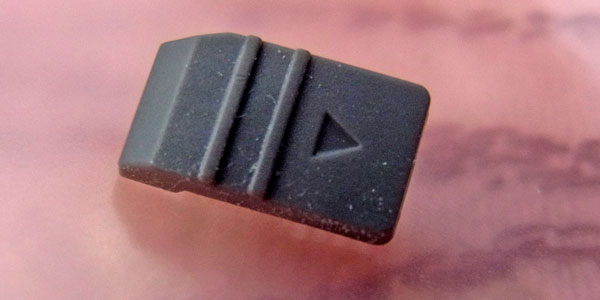
Photo: The broken battery locking slider from above
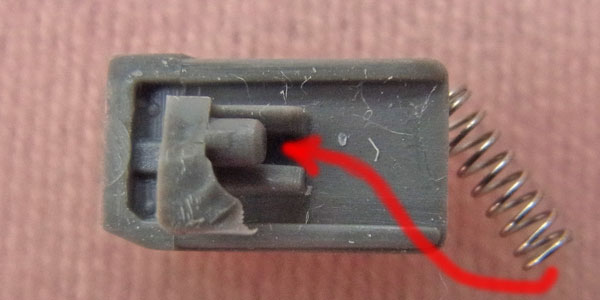
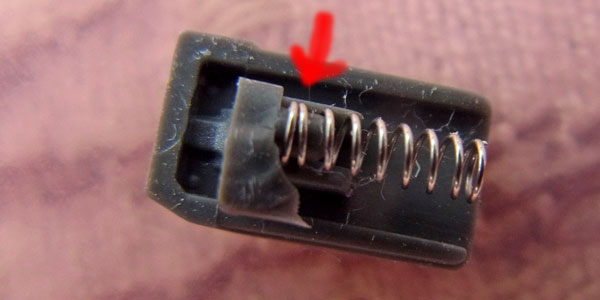
Photos: The broken battery locking slider* from underneath and how to attach the spring to the slider before pressing it into its compartment. Note that the two plastic barns that keep the slider in its compartment are missing (broken...).
All in all, if this should happen to you, call the Leica service for a replacement part - or better - for arranging a repair. By the way, in the meantime, I already sent the link to this page to forum posters who had the same mishap...
*) Update (November 2016): I was notified by a German Leica X Vario user that the replacement battery locking slider that he had received from Leica az no cost looked somewhat differently at the back (no pin to put the spring on, but a hole for insertig the spring).
Tripod-Made Scratches
My tripod has a mounting screw that I can detach from the tripod and screw to the camera, which makes it easier to attach the camera to a tripod. The screw is, however, made from metal without any protective covers or coatings (see photos below).
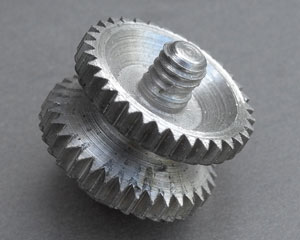 |
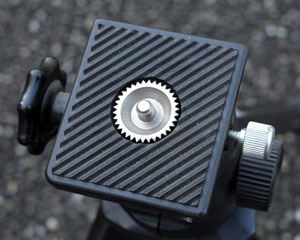 |
Photos: The metal tripod screw and its position in the tripod.
As a result, I damaged the bottom plate of my Leica X Vario a little bit (see photo below).
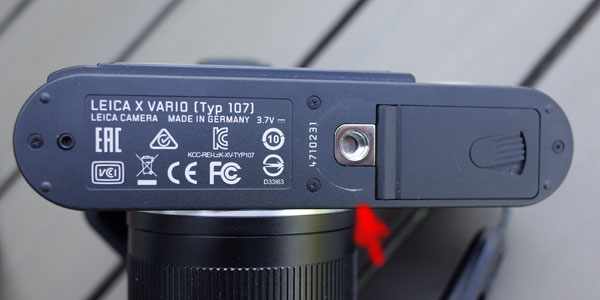
Photo: The scratch in the bottom plate of the camera
Later, I put a small piece of paper between the screw and the camera bottom, but then it was already too late. Of course, any unprotected tripod mount has the potential to damage the bottom plate. The following photos demonstrate how I protect the bottom plate with a simple piece of paper (too late, though...).
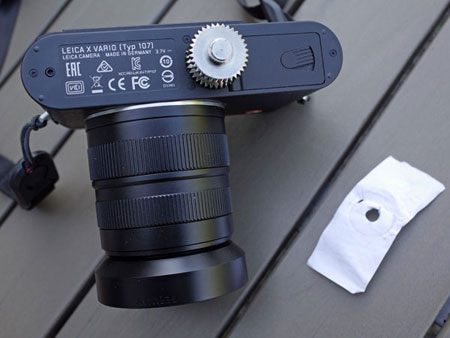 |
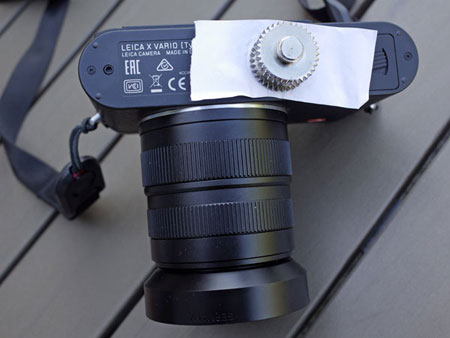 |
|
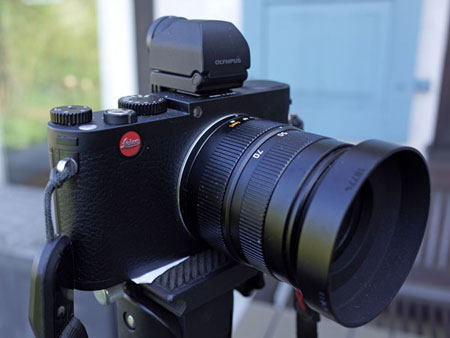 |
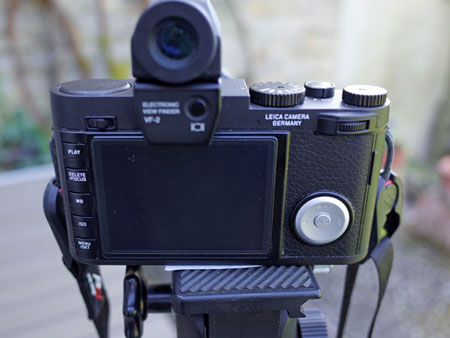 |
Photos: Using a piece of paper to protect the camera's bottom plate - quick-and-dirty but effective... (click images for larger versions)
From this experience, I learned a number of things:
- Be careful when mounting the X Vario to a tripod. If there is no protection, use simply paper (or strong plastic foil) to protect the camera's bottom plate.
- The camera's bottom plate is made of aluminum that is painted black. Any deeper scratches will make the "real" color of the bottom plate (a light gray) appear.
Dust in the Lens or on the Sensor?
Update: Leica cleaned the sensor - and the dust on the photos was gone (see below)!
One might certainly debate, whether the issue that I describe here is a "damage" to the camera, but at least here is the best location to report this issue. At the end of February 2015, I took some sunset photos and set aperture to f/16 at focal length to 70 mm (equiv.). When looking at the photos afterwards, I realized in all five photos a dust particle at the upper right edge. Here are two of them:
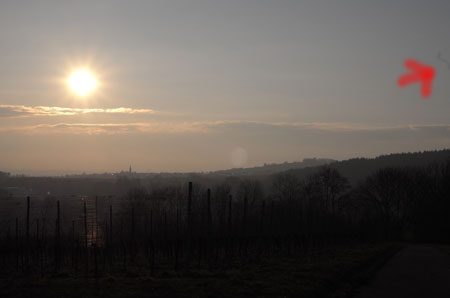 |
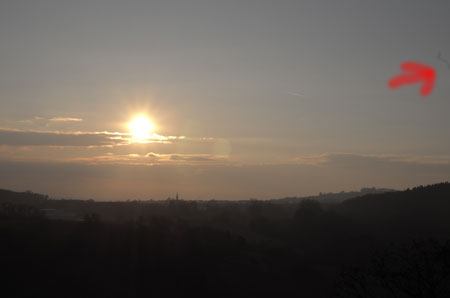 |
|
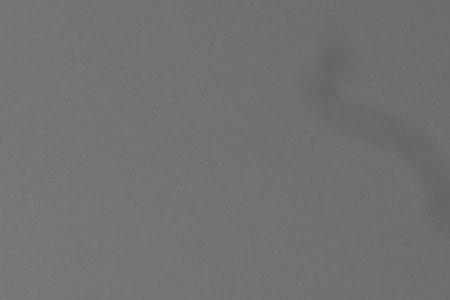 |
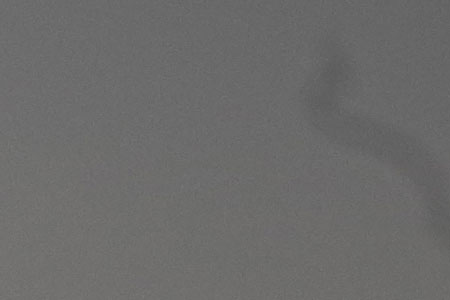 |
Photos: Overview photos and sample 100% sections with dust at the top right edge (click images to see the original photos)
Closer Examination...
A few days later, I examined the issue more closely by taking sky shots. I varied the focal length as well as the aperture and even created two short movies in which I changed the aperture. My results were as follows:
- The dust was most visible at a focal length of 70 mm (equiv.). When I slowly turned the zoom ring at the lens, the dust moved out of the screen (but did not turn) and was more or less invisible at a focal length of about 35 mm (equiv.).
- As expected, the dust looked fuzzier, when I opened the aperture. At at focal length of 70 mm (equiv.), it can still be recognized at the maximum aperture of f/6.4 with some effort (use the original photo for this).
See here for sample photos: focal length, aperture.
Videos: Changing the Focal Length
I created two sample videos, in which I zoomed the lens between 70 mm and about 50 mm and back again (note the noise at the end of the videos shortly before reaching 70 mm again): Video 1, Video 2 (both mp4)
Dust History
When I looked at older photos, I found that I was able to track back the dust issue until the end of March 2014, that is for nearly a year. See here for details.
Preliminary Conclusion and Outcome
My first thought was that this phenomenon was caused by dust on the sensor. But the finding that the dust was most visible at a focal length of 70 mm, led me to conclude that the issue was not caused by dust on the sensor, but by dust somewhere in the lens. Admittedly, I would have expected such an issue for the "folding" lenses of my Ricoh cameras, but not for the "classic" Leica X Vario lens construction. Obviously, however, my conclusion was not true...
I prepared a DVD for Leica with sample photos and the two movies, called their customer service at the end of March 2015, and sent the camera to Leica for repair at the beginning of April 2015. A week later (April 8, 2015), I received an e-mail stating that Leica would clean the sensor at no cost. Thus, Leica was convinced that the issue was caused by dust on the sensor.
About three weeks later (April 21, 2015), I received my X Vario back from Leica, where, according to them, the sensor had been cleaned (and maybe the camera a little bit as well...). The test photos that I made the same day (at f/16, 70 mm equiv.) did not show any indication of dust. So the trip to Leica was successful!
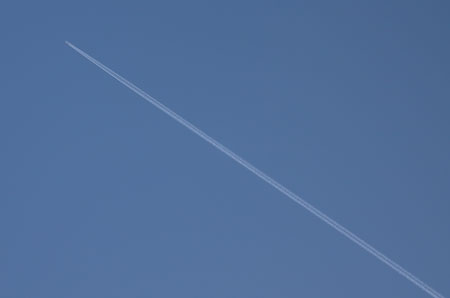 |
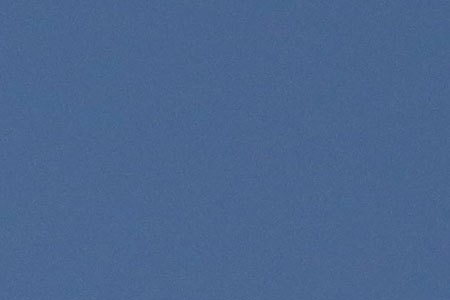 |
|
| f/16, 70 mm equiv. | ||
Afterword...
In an accompanying letter, I also addressed my white-balance and autofocus issues and sent the respective sample photos to Leica as well. Finally, I mentioned that the shutter button got stuck on rare occacsions. There were no reactions from Leica on all this (maybe, they addressed the shutter button issue - see below). The DVD with the sample photos was returned together with the camera, but not so the letter...
Dust on the Sensor (2)
After a Sweden vacation in August 2016, I once again found a larger dust particle on the sensor (the dust spot appeared on photos that I took in Bad Rappenau, Germany, on August 31, 2016, for the first time). So I took my Ricoh GXR A16 24-85 with me on my next vacation in France in September (but this camera also showed dust on the sensor after a few days, even though the sensor is hidden in the camera unit) and sent the camera to Leica once more at the end of October 2016.
Thankfully, Leica cleaned the camera sensor at not cost (plus the shutter button was repaired, which had an issue for quite some time...) and returned the camera to me in November 2016. But when I tested the camera against the sky, it showed still (other) dust (not as disturbing as the first particle, but more particles). So I sent the camera to Leica for another time, where the sensor was cleaned at no cost again. The camera returned on December 7, 2016, and I immediately tested it with sky shots. Regrettably, still one major dust particle was left. I decided, however, not to send the camera to Leica for a third time, because the dust will be rarely visible on my photos.
Because I already showed enough photos of dust on the sensor, I think that I can do without these here this time... But if you want to have a look at the dust, click here.
Shutter Button
On rare occasions, the shutter button got stuck on my Leica X Vario. When this happened, it often happened several times a day, but thereafter, this typically did not happen for a long time (only during vacations...). I briefly mentioned this issue in my letter to Leica when I sent the camera to them at the end of March 2015 because of a dust issue (see above).
Leica may or may not have addressed this issue (they did not mention it...), but, at least, the button's behavior had changed thereafter - from one intermittent issue to another one. From this moment on, the button never got stuck again. But now I had another issue that appeared now and then, meaning that it was not reproducible so that I hesitated to send the camera back to Leica... I waited until October 2016 when I had to send the camera to Leica once again because of dust on the sensor. Leica acknowledged the issue and repaired it at no cost. Since there was another dust issue, I sent the camera immediately back to Leica. In the meantime (beginning of December 2016) it returned, but up to now I did not have the chance to check whether the shutter button issue has indeed gone. At least, it did not reappear during the short time that I used the camera... I will report on this item, after I have spent more time with the camera.
Issues Reported by Other Users
In the following, I list issues that were reported by other users in Leica camera forums.
Dial Labels Wearing Off
Some users reported that the labels on the dials for shutter speed and aperture wear off (see photo below). This issue is not confined to the Leica X Vario, but seems to be a "general" Leica camera issue. The labels are simply painted on the dials, and after some time the paint wears off. It would be better to engrave the labels into the dials (which are probably made of plastic), but that seems to be too expensive for "budget" cameras like Leica cameras. Luckily, my sample does not suffer from this issue yet...
By the way, in his review of the Leica X Vario (Review: Leica X Vario Defies Naysayers with Impressive Optics), Petapixel's Nelson Tan writes: "The letterings are silk screened instead of being engraved, which I find slightly disappointing." Thus, it does not only to seem disappointing, it is a potential issue (see Design Issues).
Scratches Caused by Strap Metal Rings
A further issue that a user reported is caused by the metal rings that some straps (including the original Leica ones) use for attaching them to the camera. Even though there was some leather protection, the metal rings touched and damaged the top plate of the camera (also made of aluminum; see photo below).
The following photo was taken from the respective posting in the l-camera forum (I added the arrows) and demonstrates both issues:
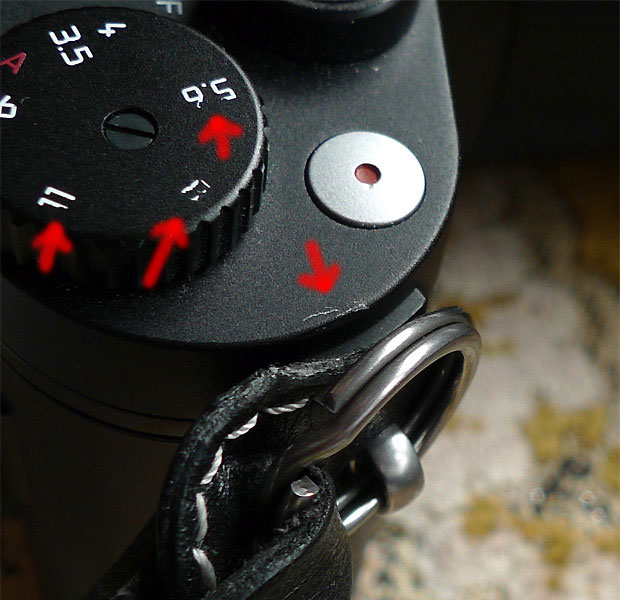
Photo: "Vanishing" labels on aperture dial and scratches caused by the metal ring from the leather strip (original Leica wrist strap).
With my Peak Design straps, there is little danger that I may scratch the top plate although even plastic may wear off paint (see photo below)...
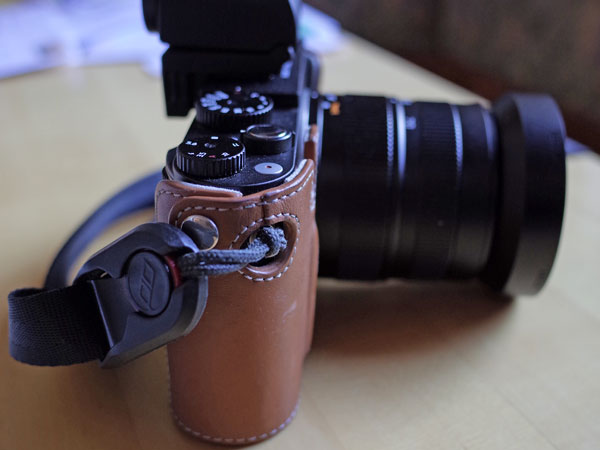
Photo: Peak Design straps have fairly "safe" strap ends...
| 03.04.2019 |